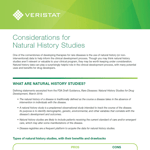1 min read
SCOPE: Powering the Future of Clinical Research
Meet Veristat at SCOPE: Powering the Future of Clinical Research February 2-5, 2026
🔬 Advancing Clinical Research with...
4 min read
Veristat’s Science Advisory Board met on 14 March 2023 to discuss Executing Patient-Focused Drug Development (PFDD), with a focus on the application in rare diseases.
Patient health and wellness extend beyond biology and symptoms of disease, encompassing functional status (day-to-day experience), access to care, health perceptions, and quality of life. Depending on the severity and outcome of disease, there may be certain benefit-risk tradeoffs between improving the biological and physiological impact of disease and enhancing the patient’s daily function and quality of life. For instance, chemotherapies extend cancer patients’ lives but come with significant adverse effects that impact the patient but may be acceptable in the setting of a life-threatening disease. In other settings, patients may be less tolerant of such adverse effects, making certain treatments less viable options, despite their potential impact on disease biology.
As the drug development industry continues to shift towards a patient-centric approach, real-world data is crucial for informing medical product development and regulatory decision-making. To develop a patient-focused strategy, researchers must gain a deep understanding of various aspects of the patient experience, including their primary concerns and the burden of disease and existing treatments. These factors vary substantially among individuals and diseases and therefore should be considered separately for each indication examined.
Patient experience data can be defined as information collected from any persons (including patients, family members and caregivers of patients, patient advocacy organizations, etc.) that are intended to provide information about patients’ experiences with a disease or condition, including the perspectives, needs, and priorities of patients including but not limited to (Cures Act, 2016):
Patient experience data may include:
One of the cornerstones of developing therapies  for rare diseases is the use of natural history (or non-interventional) data to help inform the clinical development process. Learn more about the types of natural history studies, their benefits, drawbacks, and when they are the most useful. Download Now
for rare diseases is the use of natural history (or non-interventional) data to help inform the clinical development process. Learn more about the types of natural history studies, their benefits, drawbacks, and when they are the most useful. Download Now
When patients, caregivers, and/or patient advocates are actively engaged in the development process or program planning, sponsors can better inform clinical trial design, trial endpoint development and selection, and regulatory reviews, including benefit-risk assessments.
Early and active involvement of patients and patient organizations can direct research, thereby allowing sponsors to target products that have potential therapeutic effects across the specific functional or symptomatic aspects that are most meaningful to patients. Sponsors can use this information to determine which measurement tools are most suitable for assessing disease progression among these critical items, as well as how frequently the measurement scales will need to be re-assessed in relation to the expected day-to-day variability and the rate at which disease progression occurs.
The patient experience also plays a crucial role in influencing regulatory agencies and shaping the assessment of risks and benefits for novel treatments. FDA and EMA use scientific expertise to evaluate the benefits of a novel drug and determine the level of uncertainty surrounding those benefits. The same process occurs with risks.
The balance between risk and benefit is subjective and must consider patients’ perspectives and willingness to tolerate the associated risks of the novel therapy. Patients suffering from rare and/or devastating diseases that drastically impact their daily function, have shortened life expectancy, or accelerated disease progression may be more inclined to accept a higher level of risk for the opportunity to alter the course of disease.
Patient organizations can educate the FDA directly through two meeting opportunities:
To ensure that the needs and concerns of patients and consumers are represented, the EMA directly engages with a network of more than thirty-five eligible patients and consumers organizations.
As the FDA becomes more educated on the patient experience through PFDD meetings and listening sessions, it is critical for sponsors to also connect with patients, caregivers, and advocates so that the planned endpoints to establish and confirm an effective treatment remain relevant and impactful for patients and the course of their disease. PFDD is an important approach for validating endpoints and ensuring that they are:
Other advantages of PFDD include:
The ultimate success of a clinical development program lies in answering the fundamental question of whether a drug is safe and effective in positively impacting the patient’s disease, functional capability, and quality of life. Prioritizing patient experience early on and throughout the clinical development program can improve the chances of a successful study in terms of statistical and clinical significance as well as the impact on patients.
If the goal is to take a patient-focused approach, Veristat experts recommend involving the patient experience within your study and program planning, starting with smaller discussions, focus groups, or interviews with patients, caregivers, or advocates.
Learn more
1 min read
Nov 20, 2025 Veristat Events
🔬 Advancing Clinical Research with...
1 min read
Oct 22, 2025 Veristat Events
Veristat is excited to attend the ASH Annual Meeting and...